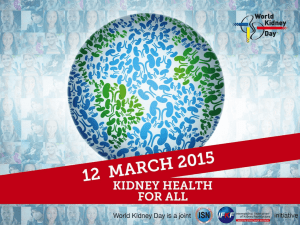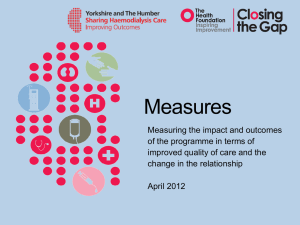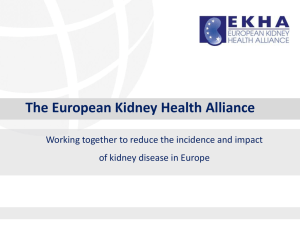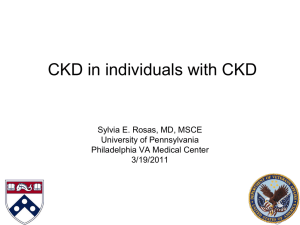Comb. Exerc
advertisement
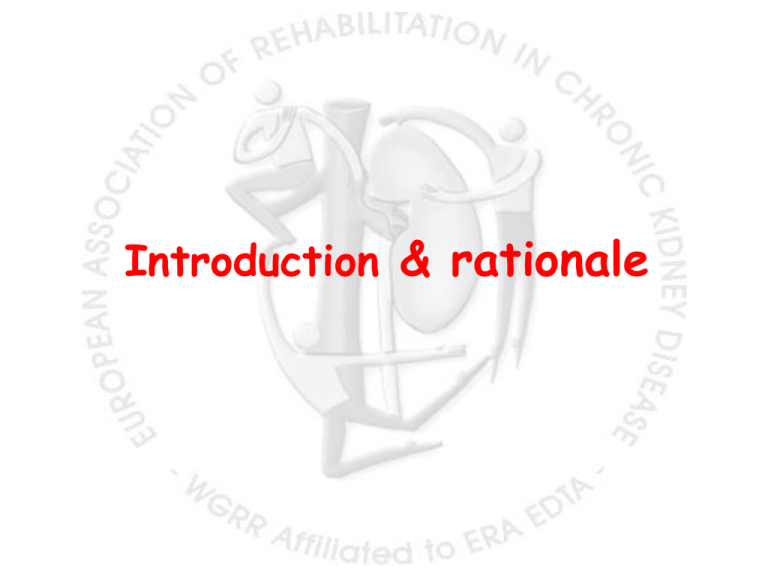
Introduction & rationale Aims of Exercise rehabilitation for the patient with CKD Morbidity Quality of life Survival Financial Cost to Health Care System ? PHYSICAL FUNCTION Morbidity Quality of life Survival Peripheral vascular resistance Endothelial vasodilation inflammation Uraemic status + comorbidity Autonomic dysfunction LV dysfunction catecholamines Nutritional deficits Altered muscle nutrient supply and metabolism INACTIVITY & AGING MUSCLE WASTING SURVIVAL Functional Independence QOL Koufaki 2004 VO2 peak and Survival Survival as function of baseline VO2peak for 175 ambulatory ESRD patients (Sietsema et al 2004 Kidney International, 65, 719-724) > Functional Capacity and Survival Survival by Kaplan-Meier in male patients according to the presence of HGS (log rank 23.0, P< 0.0001): Evaluated at start of RRT median; n=53 < median; n=52 Stenvinkel et al. (2002) Nephrology Dialysis Transplantation, 17: 1266-1274 Inactivity-Malnutrition and Survival n=2264, 1 year survival Non-sedentary sedentary Sedentary patients: 62% greater risk of dying within 1 year O’Hare AM et al. AJKD 2003;41:447-54 Muscle Mass and Survival Poor nutritional status and muscle wasting strongly associated with morbidity, mortality and physical functioning Protective effect of BMI >25kg/m2 limited to those with normal or high muscle mass Beddhu S et al. JASN 2003;14:2366-72 Mercer/Thessaloniki2006 Disuse-Disability Spiral Painter (1996) Stages of Kidney Failure: Exercise interventions? Stage Description At increased risk GFR (mL/min/1.73m2) >90 (with CKD risk factors) 1 Kidney Damage with normal or GFR 90 2 Kidney Damage with mild GFR 60-89 3 Moderate GFR 30-59 4 Severe GFR 15-29 5 Kidney Failure <15 NKF (2002) KDOQI guidelines. AJKD 39; S1-S246 Action Screening (CKD risk reduction) Diagnosis & treatment/comorbid conditions, slowing progression, CVD risk reduction Estimating Progression Evaluating & treating complications Preparation for kidney replacement therapy Replacement or dialysis Mercer/Biomove2004 Overview >20 years of published research exercise intervention studies EWGRR nucleus members > 50 years combined experience of exercise prescription for CKD patients Most stages of disease trajectory (CKD1-5) Organised Scientific and Professional meetings Sharing of experience Assessments & Evaluation methods Why Test? – Categorise patients to different risk factor groups – Establish physiological impairment and determine prognosis – Evaluate the presence and severity of symptoms – Identify potential life threatening situations – Determine safe and effective exercise rehabilitation intensities – Evaluate responses to interventions CONTRAINDICATIONS FOR PARTICIPATION IN AN ESRD REHABILITATION PROGRAM • Unstable hypertension • Congestive heart failure (>II class of NYHA) • Cardiac arrhythmias (>II class of Lown) • Recent myocardial infarction • Unstable angina • Active liver disease • Uncontrolled diabetes mellitus • Significant cerebral or peripheral vascular disease • Persistent hyperkalemia before dialysis • Severe orthopaedic limitation • Non-compliant patients Which Test? Cardiorespiratory exercise testing Cycle ergometer test Most commonly used test for (sub)maximal exercise testing Younger patients: WHO-protocol Elderly, deconditioned patients smaller increments of 10 watts / min Most renal patients:premature test termination due to localised leg fatigue Parameters in renal patients: ECG, heart rate, blood pressure acid-base status, blood lactate WHO - Protocol 150 power output (watts) 125 100 75 50 25 0 2 4 6 8 10 12 time (min) Functional Capacity Assessment • valid, expedient, low-tech option – (degree of accuracy-expediency trade-off) • timed assessments • • • • • Walk tests Stair-climbing Chair stands (sit-to-stand) Balance tests Test battery • reflect tasks performed in everyday life (ADL) – more relevantly assess physical dysfunction in elderly patients • independently predict disability Incremental Shuttle Walk Test Relationship between SWT distance and VO2 peak 40 VO2 peak (ml.kg.min -1) 35 30 y = 0.028x + 3.5923 r= 0.93; R2 = 0.86 25 20 15 10 5 100 200 300 400 500 600 700 800 900 1000 1100 1200 SWT Distance (m) North Staffordshire Functional Capacity Assessment Battery • Sit-to-stand 5 (STS5):Time (s) to perform 5 sit to stand movements (46cm chair height) - surrogate measure of muscle power • Sit-to-stand 60 (STS60): Number of sit to stand movements achieved in 60 seconds -surrogate measure of muscle endurance; • Walk-Stair Climb/Stair Descent (Climb/Descent): Time (s) to walk to and ascend/descend two flights of stairs (22 stairs, 3.3 metre elevation) (Mercer et al, 1998) – ADL-related functional capacity • Incremental Shuttle Walk Test (Singh et al, (1992) Thorax, 47 (12): 1019-24) – proxy measure of peak exercise capacity (estimated VO2 Peak) Sportmotorische Tests bei chronisch Nierenkranken Sit-to-Stand (Chair rise) Tests Standard height chair (42-46cm) A:Time to perform (“muscle power” ) • Sit-to-Stand-to-Sit • Sit-to-stand 5 : (Koufaki et al, 2002) • Sit-to-Stand 10: (Painter et al, 2002) B:Number achieved (“muscle endurance”) • Sit-to-stand 30 (McDonald et al, 2003) • Sit-to-stand 60: (Koufaki et al, 2002) How to Exercise the patient with CKD? RECOMMENDATIONS SHOULD BE BASED ON: PARTICULAR PATHOLOGY OF THE PATIENT RISK FACTORS PROFILE BEHAVIOURAL CHARACTERISTICS PERSONAL GOALS THE INDIVIDUAL’S RESPONSE TO EXERCISE MEASUREMENTS OBTAINED DURING CARDIOPULMONARY EXERCISE TESTING EXERCISE PREFERENCES CURRENT MEDICATIONS Aerobic Exercise Training: haemodialysis Bed cycle ergometer training Aerobic Exercise Training: haemodialysis Stationary cycle ergometer training Resistance Training Supervised outpatient and haemodialysis Fixed weight machines Therabands & Light weights Body weight resisted exercises Exercise Intervention Formats • Prescribed supervised exercise • During Haemodialysis (HD Unit) • Supervised outpatient training • Prescribed unsupervised exercise • cycle ergometer at home (Konstantinidou et al., 2002) • walking at home (Painter et al., 2000) • Unsupervised exercise • coaching/counselling (information/video) • walking & exercise diary (Fitts et al, 1999) • Encouragement to be Physically Active • education/counselling (information/demonstration) • lifestyle/activity choices (Tawney et al., 2000) HOW TO TRAIN PATIENTS WITH CRF? Supervised Outpatient Rehabilitation OUTPATIENT REHABILITATION PROGRAM Timing of exercise: Off - dialysis days Type of exercise: Walking / Jogging Stationary cycling Swimming Aerobics- Calisthenics Team sports Frequency: 3 times /week Duration: 90 min Intensity: 60-70 % HR reserve Borg scale 13-14 67 Very, very light 8- Borg’s category RPE scale 9 1011 Light 1213 ratings of perceived exertion Very light Somewhat hard 1415 Hard 1617 Very hard 1819 Very, very hard 20- maximal Supervised outpatient exercise training • performed for > 25 years • adopted from cardiac rehabilitation programs • walking, jogging, small games, gymnastics, swimming • more than 100 studies showing beneficial physical and psycho-social effects • number of patients < 20 / study • age < 50 years OUTPATIENT REHABILITATION PROGRAM MODES GOALS AEROBIC VO2peak LARGE MUSCLE ACTIVITIES PEAK WORK & & AT ENDURANCE INTENSITY/ DURATION/ FREQUENCY BORG RPE 11-16 40-70% VO2peak TIME TO GOAL 4-6 MONTHS 3-7 days / week 20-40 min/session STRENGTH ATROPHY CIRCUIT TRAINING FLEXIBILITY UPPER & LOWER BODY RANGE-OFMOTION ACTIVITIES RISK OF INJURY HIGH REPETITIONS LOW RESISTANCE 2-3 days / week 4-6 ΜONTHS 3 MONTHS STEADY STATE TRAINING FREQUENCY OF SESSIONS: • SHORT DAILY SESSIONS OF 5-10 min FOR COMPROMISED PATIENTS • LONGER SESSIONS (20-30 min) 3-5 TIMES / WEEK FOR FIT PATIENTS INTENSITY OF TRAINING SESSIONS: INITIAL STAGE: 40-50 % VO2peak FOR 5-15 min IMPROVEMENT STAGE: 50-80 % VO2peak FOR 15-30 min MAINTENANCE STAGE: AFTER THE 6TH MONTH OF TRAINING THE BENEFICIAL EFFECTS WILL BE LOST AFTER ONLY 3 WEEKS OF ACTIVITY RESTRICTION PATIENT’S MONTHLY CARD NAME: Medications: Comments: REST DATE BP HR WARM UP AEROBIC BP BP HR HR RESISTANCE COORDINATION COOL DOWN BP HR BP HR BP HR COMMENTS Intra-dialytic Rehabilitation Physical Activity and Movement Therapy at KfH DVD clip here HAEMODIALYSIS REHABILITATION PROGRAM Timing of exercise: During haemodialysis Type of exercise: Stationary cycling flexibility strength co-ordination relaxation training Frequency: 3 times /week Duration: 60-90 min Intensity: 60-70 % HR reserve Borg scale 13-14 RESISTANCE EXERCISE TRAINING HD PATIENTS RHYTHMIC STRENGTH EXERCISES SMALL MUSCLE GROUPS SHORT BOUTS OF WORK SMALL NUMBER OF REPETITIONS WORK/RECOVERY-RATIO OF >1:2. Resistance training Supervised Outpatient (CKD3-5) Large Muscle Groups 50%-80% 1-3 repetition maximum (RM) Progressing to 3 sets of 8-10 reps 2-3 days per week Progression: Reassess RM regularly Exercise in patients with ESRD Home training? Relatively little information in patients with ESRD More suitable for younger and well trained patients Exercise Training: Context Issues Safety/Feasibility/Compliance/Outcomes Safety & Risk Exercise during haemodialysis Effect of fluid removal on cardiovascular response and adverse reactions 8 patients (mean age 46.9 years) HD 3 x 3.5 h / week submaximal exercise on stationary cycle ergometer (5 min, 60 % VO2 max) before and after 1, 2, 3 hours of dialysis normal cardiovascular response to exercise during first 2 hours of dialysis after 3 hours only 3 of 8 patients could exercise because of cramps and cardiovascular instability i.e. decreasing stroke volume and heart rate no cardiovascular and clinical problems when fluid removal < 800 ml / h (2500 ml) Fluid Removed (L) 5 mean UF 1356 ml / h 4 3 2 1 0 0 1 2 3 Hours of Dialysis Moore et al. Am J Kidney Dis 31: 631-637 (1998) Adverse effects/complications Exercise during haemodialysis Exercise programs in the Ruhr area, Germany i.e. Essen/Oberhausen/Velbert/Gelsenkirchen (1995- 2005) 20 - 200 patients, 2-3 training sessions/week > 50 000 individual training sessions - several cases of muscle cramps in the lower legs - single dislocations of a dialysis needle with haematoma - one case of loosened dialysis needle by sweating - no severe (cardiovascular) complications Adverse effects/complications North Staffordshire Exercise on Dialysis Project (1998-2001) ~100 patients, 3 aerobic training sessions/week > 4,000 individual training sessions > 300 peak exercise tests - One case of severe autonomic dysregulation Risk Context 100,000 patient exercise hours Overall Complication rate Exercise training and cardiac rehabilitation 3.5 3 2.5 2 1.5 1 0.5 0 Medically Medically Outpatient Outpatient supervised supervised Morning Afternoon Adapted from Franklin et al. Chest: 1998 Safety of Exercise Training • Pre-participation screening • Exercise tolerance assessment – Individualised exercise prescription • Warm-up • Regular monitoring during exercise sessions – Heart rate, blood pressure, Ratings of Perceived Exertion, exercise work rate • Cool-down • Controlled Progression – Establish behaviour (make it routine) – Increase Exercise tolerance (gradually duration) • Periodic reassessment of exercise tolerance – Individualised exercise prescription Feasibility & Compliance Feasibility Outpatient exercise program in patients on maintenance haemodialysis total number of patients 174 (100 %) transportation difficulties 70 ( 40 %) co-existing medical problems 54 ( 31 %) patients invited to participate 50 ( 29 %) patients starting with exercise program 17 ( 10 %) number of exercisers after 12 weeks 14 ( 8 %) 7 men, 7 women, age 25-53 (45 ± 11 years) Conclusion: Despite potential benefit the impact of exercise programs is limited as only small portion of patients able or willing to participate Shalom et al. Kidney Int 25: 958-963 (1984) Exercise training in patients on maintenance haemodialysis Germany 2003 Questionnaire on exercise rehabilitation in patients with chronic kidney disease 1164 renal units response rate 37 % (430 units) 30 000 patients treated 63 % of all German HD patients exercise training during HD 179 / 430 units outpatient program 42 / 430 units Participants in exercise programs 4000 patients 2600 3000 2000 1000 300 0 outpatient program exercise during HD Schönfelder, Krause, Daul (2003) Exercise programs for patients with end-stage renal disease Number and treatment modalities of participants Essen, Germany (1983-2003) HD TX CAPD number of patients 200 160 120 80 40 0 83 85 87 89 91 93 Year 95 97 99 01 03 Feasibility of Exercise Training • Staff support – Physicians, nurses, dieticians, physiotherapists, occupational therapists – Nearest University Exercise Science Department? – Dialysis Units with experience? • Patient interest – Patient Associations – Unit newsletter • Patient profile – recognise heterogeneity – establish patient capabilities • Exercise modes/equipment available – be creative • Match exercise/activity to patient not vice-versa Compliance Compliance North Staffordshire Exercise on Dialysis Project (1998-2002) Exercise training for CKD5 (HD & PD: n 100) Feasibility studies 3 month Low-volume aerobic + muscular endurance 3 month aerobic 3 month aerobic + muscular endurance (CAPD only) 6 month aerobic training (uncontrolled; biopsy)* 3 month EPOEX pilot study: EPO therapy ± aerobic (HD) 28-33% Dropout • • • • • Transplant Death (unrelated to protocols) Persistent illness Orthopaedic limitation/injury (unrelated to protocol) Lack of motivation Effectiveness of Exercise Training Few studies involve direct comparisons of types of exercise • Konstantinidou et al. (2002) 6 month Study (~50 years age) – (A) Supervised outpatient renal rehabilitation • 3 x 60 minutes/week (30' intermittent aerobic exercise; 6070% HRmax + resistance training) [basketball, swimming] – (B) Exercise during dialysis • 3 x 60 minutes/week (bed cycle ergometer; 30 minutes continuous aerobic exercise; 70% HRmax + lower limb strength/flexibility exercises) – (C) Unsupervised home-based moderate exercise • 5 x 30 minutes/week (cycle ergometer; 50-60% HRmax + flexibility and muscular endurance exercises) – (D) Control group - Standard therapy Effectiveness of Exercise Training 50 45 Supervised Outpatient Haemodialysis Home 43 40 35 30 % 25 20 24 24 17 17 17 15 10 5 0 % VO2 peak % Drop-out Exercise on non-dialysis days most effective for those able to comply Exercise training during HD technically feasible, safe and effective Unsupervised exercise effective and safe Outcomes Costs Exercise during haemodialysis Costs of exercise rehabilitation compared to other costs of treatment 35000 30000 costs / year (€) 30000 25000 20000 14000 15000 7000 10000 3100 5000 550 550 0 HD stretcher transp. taxi EPO statins exercise Exercise During Haemodialysis Decreases the Use of Antihypertensive Medications average annual cost saving $885/patient-year (P<0.005) in the exercise group Miller et al. (2002) American Journal of Kidney Diseases, 39, (4), 828-833. ARISTOTLE UNIVERSITY OF THESSALONIKI, GREECE LABORATORY OF SPORTS MEDICINE DIRECTOR: A. DELIGIANNIS THE ROLE OF EXERCISE TRAINING ON PREVENTION AND REHABILITATION OF CARDIAC DISORDERS IN CKD PATIENTS ASTERIOS DELIGIANNIS PROFESSOR OF SPORTS MEDICINE CARDIOLOGIST CARDIOVASCULAR DISEASES ARE THE MAJOR CAUSE OF MORBIDITY AND MORTALITY IN PATIENTS WITH CHRONIC KIDNEY DISEASE CARDIAC DISTURBANCES IN CKD PATIENTS • CORONARY ARTERY DISEASE • CONGESTIVE HEART FAILURE • PERICARDITIS • CARDIAC AUTONOMIC DYSFUNCTION • ARRHYTHMIAS Foley et al, Am J Kidney Dis 1998 CAUSES OF LV SYSTOLIC AND/ OR DIASTOLIC DYSFUNCTION IN CKD PATIENTS CARDIAC HYPERTROPHY ● HEMODYNAMIC INSTABILITY MYOCARDIAL ISCHEMIA CARDIAC AUTONOMIC DYSFUNCTION MYOCARDIAL FIBROSIS ANEMIA BIOCHEMICAL ABNORMALITIES “UREMIC” TOXINS HYPERTENSION Amman & Ritz, Adv Renal Replacement Therapy, 1997 A-V FISTULA MODIFIABLE RISK FACTORS FOR CARDIOVASCULAR DISEASE IN CKD • HYPERTENSION • DIABETES • HYPERLIPIDEMIA • HYPERHOMOCYSTEINEMIA • ESRF-SPECIFIC FACTORS • SYMPATHETIC OVERESTIMATION • HYPERPARATHYROIDISM • PHYSICAL INACTIVITY Deligiannis A, Clin Nephrol 2004 LIMITING FACTORS OF EXERCISE CAPACITY IN CKD PATIENTS • CARDIORESPIRATORY INSUFFICIENCY • ANEMIA • METABOLIC DISTURBANCES • CARDIAC AUTONOMIC DYSFUNCTION • LV DYSFUNCTION • MYOCARDIAL ISCHEMIA • DEFECT OF MUSCLE OXIDATIVE METABOLISM • UREMIC MYOPATHY AND NEUROPATHY • SEDENTARY LIFESTYLE Kouidi, Sports Med 2001 CARDIORESPIRATORY FITNESS OF CKD PATIENTS Painter, Am J Kidney Dis1994 FACTORS AFFECTING CARDIORESPIRATORY CAPACITY IN CKD PATIENTS IMPROVEMENT IN HD TREATMENT RENAL TRANSPLANTATION RECOMBINAT HUMAN ERYTHROPOIETIN L-CARNITINE (?) EXERCISE TRAINING Kouidi E, Sports Med 2001 RENAL REHABILITATION PROGRAMS IN SPORTS MEDICINE LABRENAL UNIT - AHEPA HOSPITAL • DURATION: 15 years • PARTICIPATION/YEAR – OUTPATIENT – DURING HD – MEN/WOMEN – ΜΕAN AGE 15 patients 25 patients 28/12 52.5 (32-75 years) EXERCISE TRAINING AND CARDIORESPIRATORY BENEFITS IN CKD PATIENTS • EXERCISE CAPACITY VO2peak, EXERCISE DURATION • MYOCARDIAL ADAPTATIONS SV, CO peak HR rest, HR peak VENTRICULAR FILLING PEAK RATE PERFUSION? • • • • ENDOTHELIAL FUNCTION ENDOTHELIUM-DEPENDENT VASODILATION CARDIAC AUTONOMIC OUTFLOW CATECHOLAMINES HRV VENTILATORY RESPONSES VENTILATORY ABNORMALITIES SURVIVAL ? Deligiannis A, Clin Nephrol 2004 BENEFICIAL EFFECTS OF EXERCISE TRAINING ON AEROBIC CAPACITY Painter, Am J Kidney Dis1994 LONG TERM PHYSICAL TRAINING EFFECTS ON EXERCISE CAPACITY IN HD PATIENTS Kouidi et al, Clin Nephrol 2004 VO2peak CHANGES DURING 4 YEARS OF EXERCISE TRAINING IN HD PATIENTS Kouidi et al, Clin Nephrol 2004 VO2peak CHANGES DURING EXERCISE TRAINING AND DETRAINING IN HD PATIENTS Months of detraining Kouidi et al, Clin Nephrol 2004 IMPROVEMENT IN AEROBIC CAPACITY AFTER DIFFERENT MODES OF TRAINING IN HD PATIENTS Konstantinidou et al, J Rehabil Med , 2001 BENEFICIAL CARDIORESPIRATORY ADAPTATIONS OF LONG-TERM EXERCISE TRAINING PROGRAM FUNCTIONAL PARAMETERS 6 YEARS EXERCISE ON NON-DIALYSIS DAYS 3 YEARS EXERCISE DURING DIALYSIS VO2max 76% 50% EXERCISE DURATION 60% 43% DOUBLE PRODUCT 28% 17% MINUTE VENTILATION 43% 26% VENTILATORY THRESHOLD 46% 32% (% improvement) Kouidi et al. ERA-EDTA 2000 CARDIAC RESPONSE TO EXERCISE TRAINING IN HD PATIENTS COI ml/kg/min STRESS ECHO EF (%) Deligiannis et al, Int J Cardiol, 1999 LV VOLUMES BEFORE AND AFTER EXERCISE TRAINING REST 60% VO2 max Pre Post Pre Post EDVI (ml/m2) 78.4 84.9 78.9 85.4 ESVI (ml/m2) 30.6 30.6 26.7 23.4 SVI (ml/m2) 47.9 54.4 52.4 62.2 COI (L/min/m2) 4.2 4.1 6.2 7.1 LV FUNCTION BEFORE AND AFTER EXERCISE TRAINING REST 60% VO2 max Pre Post Pre Post EF (%) 61.1 64.1 66.4 73.1 SF (%) 36.2 34.6 31.4 28.5 Deligiannis et al., Int J Cardiol 1999 S. Gielen et al. Circulation, 2001 ΣΥΣΤΗΜΑΤΙΚΗ ΑΣΚΗΣΗ Κυτοκίνες υπεύθυνες για απόπτωση μυοκαρδιακών, ενδοθηλιακών και μυικών κυττάρων sFas sFasL hsCRP (;) IL-6 TNF-α ΑΝΤΙΣΤΑΣΗ ΣΤΗΝ ΙΝΣΟΥΛΙΝΗ ΕΞΕΛΙΞΗ ΤΗΣ ΑΘΗΡΟΣΚΛΗΡΥΝΣΗΣ Kouidi E. HJC 2008 ΣΥΣΤΗΜΑΤΙΚΗ ΑΣΚΗΣΗ ΚΥΚΛΟΦΟΡΟΥΝΤΑ ΕΝΔΟΘΗΛΙΑΚΑ ΠΡΟΓΟΝΑ ΚΥΤΤΑΡΑ ΑΙΜΑΤΙΚ Η ΡΟΗ ΕΝΔΟΘΗΛΙΝΗ-1 ΤΟΙΧΩΜΑΤΙΚΗ ΤΑΣΗ ΚΑΘΑΡΣΗ L-ΑΡΓΙΝΙΝΗΣ mRNA ΕΚΦΡΑΣΗ ΤΗΣ NOS ΣΥΝΘΕΣΗ ΚΑΙ ΕΚΚΡΙΣΗ NO ΑΓΓΕΙΟΔΙΑΣΤΟΛΗ Kouidi E. HJC 2008 EXERCISE TRAINING AND CORONARY ARTERY REMODELLING Linke A, et al. Prog Cardiovasc Dis 2006; 48(4): 270-284. Mustata S et al. J Am Soc Nephrol 2004; 15: 2713-8 Rus R, et al. Ther Apher Dial 2005; 9: 241-4 EXERCISE AND LIPIDS CARDIAC AUTONOMIC INSUFFICIENCY IN HD PATIENTS • • SYMPATHETIC OVERACTIVITY PARASYMPATHETIC DEPRESSION • DYSRRYTHMIAS Converse, N Engl J Med 1992 REASONS OF AUTONOMIC DYSFUNCTION • • • • • • • UREMIC NEUROPATHY CARDIAC NERVE FIBER DAMAGE PSYCHOLOGICAL TENSION, STRESS ELECTROLYTE ABNORMALITIES ANEMIA DYSFUNCTION OF CARDIAC PACEMAKER CELLS DECONDITIONING • ASSOCIATED CONDITIONS Thompson, Clin Auton Res 1991 LONG-TERM EFFECTS OF SYMPATHETIC OVERACTIVITY • MYOCARDIAL HYPERTROPHY AND FIBROSIS • BETA-RECEPTOR DOWNREGULATION • ARRHYTHMIAS • IMPAIRED BARORECEPTOR FUNCTION • ENDOTHELIAL DYSFUNCTION EFFECTS OF EXERCISE TRAINING ON CARDIAC AUTONOMIC SYSTEM • • • • • • • HR (rest, submaximal exercise) PARASYMPATHETIC TONE SYMPATHETIC TONE HRV CHRONOTROPIC RESPONSE LEVEL OF CATECHOLAMINES (?) B- MYOCARDIAL RECEPTORS(?) Deligiannis et al, Am J Cardiol, 1999 EFFECTS OF EXERCISE TRAINING ON HRV (TRIANGULAR INDEX) IN HD PATIENTS Deligiannis et al, Am J Cardiol, 1999 SPECTRAL HRV ANALYSIS BEFORE AND AFTER EXERCISE TRAINING BEFORE AFTER Kouidi et al, XXXIX EDTA Congress, 2002 EFFECTS OF EXERCISE TRAINING ON BAROREFLEX SENSITIVITY BRS (ms/mmHg) BEI (%) Petraki M et al Clin Nephrol 2008 Pearson’s Correlation Coefficients between Baseline and Follow up measurements for trained HD patients. Baseline / follow up VO2peak SDNN LF/HF MSSD PNN50 BDI HADS VO2peak ,937(**) ,611(**) ,590(**) ,468(*) ,789(**) -,846(**) -,689(**) SDNN ,877(**) ,648(**) ,548(**) ,556(**) ,890(**) -,835(**) -,728(**) LF/HF ,619(**) ,429(*) ,880(**) ,490(*) ,555(**) -,531(**) -,637(**) MSSD ,797(**) ,467(*) ,472(*) ,385 ,971(**) -,789(**) -,649(**) PNN50 ,752(**) ,444(*) ,415(*) ,353 ,984(**) -,744(**) -,607(**) BDI -,942(**) -,487(*) -,597(**) -,411(*) -,797(**) ,915(**) ,769(**) HADS -,733(**) -,397 -,602(**) -,435(*) -,608(**) ,710(**) ,870(**) ** Correlation is significant at the 0.01 level (2-tailed). * Correlation is significant at the 0.05 level (2-tailed). Depression, heart rate variability and exercise training in dialysis patients. E. Kouidi et al; in press Results of Patients Defined as High Risk Group A Group B Baseline Follow-up P Baseline Follow-up VO2peak ml/kg/min <14 9 - <0.05 7 7 NS LVEF ≤30 % 5 5 NS 7 7 NS SDNN 70 ms 4 2 <0.05 6 6 NS SAECG Positive (%) 7 4 <0.05 9 9 NS TWA Positive (%) 7 6 NS 6 6 NS P Effects of Exercise Training on Non-invasive Cardiac Measures in Patients undergoing Chronic Hemodialysis: A Randomized Controlled Trial. E. Kouidi, et al. AJKD, in press EFFECTS OF EXERCISE TRAINING ON CARDIAC ARRHYTHMIAS Trained Baseline Arrhythmias-Lown 12 Controls Follow-up 8* Baseline 12 Follow-up 13 Class >II (no.) *p<0.05 Deligiannis, Am J Cardiol 1999 Miller BW, et al. Am J Kidney Dis 2002; 39(4): 828-33 EFFECTS OF AEROBIC TRAINING IN CKD PATIENTS Moinuddin I and Leehey DJ. Adv Chronic Kidney Dis 2008;15: 83-96 EFFECTS OF RESISTANCE TRAINING IN CKD PATIENTS Chan M et al, J Ren Nutr. 2007; 17: 84-7. EFFECTS OF RESISTANCE TRAINING IN CKD PATIENTS Moinuddin I and Leehey DJ. Adv Chronic Kidney Dis 2008;15: 83-96 ABNORMAL HEMODYNAMIC RESPONSES TO EXERCISE IN HD PATIENTS • INAPPROPRIATE HR RESPONSE • VO₂ REACHES TO PEAK QUICKER THAN IN HEALTHY INDIVIDUALS • GREATER RELIANCE ON ANAEROBIC METABOLISM (WITHOUT HIGH LEVEL OF LACTATE) • INCREASED SYSTEMIC VASCULAR RESISTANCES • DECREASED BLOOD FLOW TO WORKING MUSCLES • SMALL (?) INCREASES IN SV AND CO • ACTIVATION OF BOTH CARDIAC MECHANISMS («STARLING LAW» AND CONTRACTILITY) Moore et al, Med Sci Sports Exerc 1993 Deligiannis A, Clin Nephrol 2003 SUMMARY OF CARDIAC BENEFITS FOLLOWING EXERCISE TRAINING IMPROVED CARDIORESPIRATORY INSUFFICIENCY POSITIVE LV REMODELING EFFECTS (?) INCREASED SYSTOLIC FUNCTION AUGMENTED MYOCARDIAL CONTRACTILITY IMPROVED DIASTOLIC FUNCTION (?) REDUCED PERIPHERAL RESISTANCES (?) INCREASED CARDIAC VAGAL ACTIVITY DECREASED ARRHYTHMIAS (?) MANAGEMENT OF HYPERTENSION (?) Deligiannis A, Clin Nephrol 2004 CONCLUSION • EXERCISE TRAINING IN HD PATIENTS IMPROVES PHYSICAL FITNESS, CARDIAC FUNCTION AND CORRECTS CARDIAC AUTONOMIC DYSFUNCTION • THESE IMPROVEMENTS HAVE BENEFICIAL EFFECTS ON PREVENTION OF CORONARY ARTERY DISEASE REMARKS… • EACH HD PATIENT SHOULD PARTICIPATE IN RENAL REHABILITATION PROGRAMS • INITIAL IMPROVEMENTS OCCUR AT 4 WEEKS AND PEAK ADAPTATIONSARE SEEN AT 16-26 WEEKS OF TRAINING • ALL EXERCISE BENEFITS ARE LOST WITHIN A FEW WEEKS OF DETRAINING


